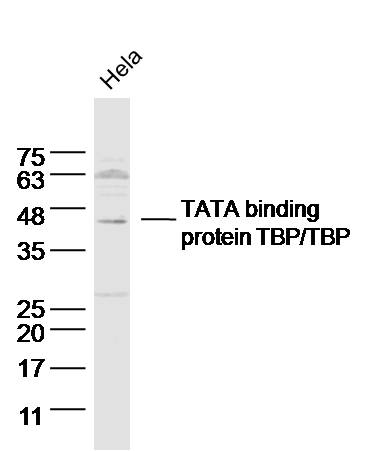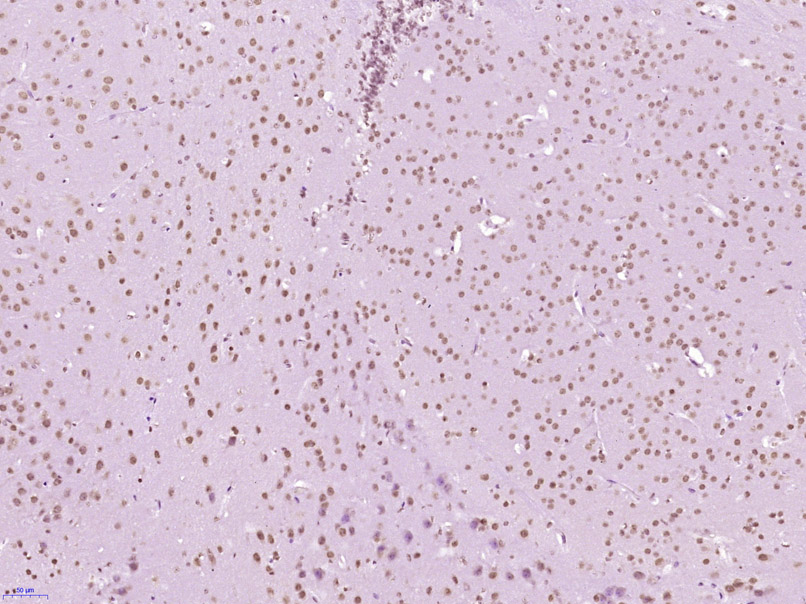
Rabbit Anti-TBP antibody
TBP_HUMAN; TATA-box-binding protein; TATA-box binding protein; GTF2D1; TF2D; TFIID; TATA sequence-binding protein; TATA-binding factor; TATA-box factor; Transcription initiation factor TFIID TBP subunit; HDL4; TBP1; GTF2D; SCA17;
View History [Clear]
Details
Product Name TBP Chinese Name TATABinding protein抗体 Alias TBP_HUMAN; TATA-box-binding protein; TATA-box binding protein; GTF2D1; TF2D; TFIID; TATA sequence-binding protein; TATA-binding factor; TATA-box factor; Transcription initiation factor TFIID TBP subunit; HDL4; TBP1; GTF2D; SCA17; literatures Research Area Cell biology Neurobiology Stem cells transcriptional regulatory factor Epigenetics Immunogen Species Rabbit Clonality Polyclonal React Species Human, Mouse, (predicted: Rat, Chicken, Dog, Pig, Cow, Horse, Rabbit, ) Applications WB=1:500-2000 ELISA=1:5000-10000 IHC-P=1:100-500 IHC-F=1:100-500 ICC=1:100 IF=1:100-500 (Paraffin sections need antigen repair)
not yet tested in other applications.
optimal dilutions/concentrations should be determined by the end user.Theoretical molecular weight 38kDa Cellular localization The nucleus Form Liquid Concentration 1mg/ml immunogen KLH conjugated synthetic peptide derived from human TATA binding protein TBP: 201-339/339 Lsotype IgG Purification affinity purified by Protein A Buffer Solution 0.01M TBS(pH7.4) with 1% BSA, 0.03% Proclin300 and 50% Glycerol. Storage Shipped at 4℃. Store at -20 °C for one year. Avoid repeated freeze/thaw cycles. Attention This product as supplied is intended for research use only, not for use in human, therapeutic or diagnostic applications. PubMed PubMed Product Detail Initiation of transcription by RNA polymerase II requires the activities of more than 70 polypeptides. The protein that coordinates these activities is transcription factor IID (TFIID), which binds to the core promoter to position the polymerase properly, serves as the scaffold for assembly of the remainder of the transcription complex, and acts as a channel for regulatory signals. TFIID is composed of the TATA-binding protein (TBP) and a group of evolutionarily conserved proteins known as TBP-associated factors or TAFs. TAFs may participate in basal transcription, serve as coactivators, function in promoter recognition or modify general transcription factors (GTFs) to facilitate complex assembly and transcription initiation. This gene encodes TBP, the TATA-binding protein. A distinctive feature of TBP is a long string of glutamines in the N-terminus. This region of the protein modulates the DNA binding activity of the C terminus, and modulation of DNA binding affects the rate of transcription complex formation and initiation of transcription. The number of CAG repeats encoding the polyglutamine tract is usually 25-42, and expansion of the number of repeats to 45-66 increases the length of the polyglutamine string and is associated with spinocerebellar ataxia 17, a neurodegenerative disorder classified as a polyglutamine disease. Two transcript variants encoding different isoforms have been found for this gene. [provided by RefSeq, Jul 2016]
Function:
General transcription factor that functions at the core of the DNA-binding multiprotein factor TFIID. Binding of TFIID to the TATA box is the initial transcriptional step of the pre-initiation complex (PIC), playing a role in the activation of eukaryotic genes transcribed by RNA polymerase II. Component of the transcription factor SL1/TIF-IB complex, which is involved in the assembly of the PIC (preinitiation complex) during RNA polymerase I-dependent transcription. The rate of PIC formation probably is primarily dependent on the rate of association of SL1 with the rDNA promoter. SL1 is involved in stabilization of nucleolar transcription factor 1/UBTF on rDNA.
Subunit:
Binds DNA as monomer. Belongs to the TFIID complex together with the TBP-associated factors (TAFs). Component of the transcription factor SL1/TIF-IB complex, composed of TBP and at least TAF1A, TAF1B TAF1C and TAF1D. Association of TBP to form either TFIID or SL1/TIF-IB appears to be mutually exclusive. Interacts with TAF1A, TAF1B and TAF1C. Interacts with TFIIB, NCOA6, DRAP1, DR1 and ELF3. Interacts with SPIB, SNAPC1, SNAPC2 and SNAPC4. Interacts with UTF1. Interacts with BRF2. Interacts with UBTF. Interacts with GPBP1. Interacts with CITED2 (By similarity). Interacts with ATF7IP. Interacts with HIV-1 Tat.
Subcellular Location:
Nucleus.
Tissue Specificity:
Widely expressed, with levels highest in the testis and ovary.
DISEASE:
Defects in TBP are the cause of spinocerebellar ataxia type 17 (SCA17) [MIM:607136]. Spinocerebellar ataxia is a clinically and genetically heterogeneous group of cerebellar disorders. Patients show progressive incoordination of gait and often poor coordination of hands, speech and eye movements, due to degeneration of the cerebellum with variable involvement of the brainstem and spinal cord. SCA17 is an autosomal dominant cerebellar ataxia (ADCA) characterized by widespread cerebral and cerebellar atrophy, dementia and extrapyramidal signs. The molecular defect in SCA17 is the expansion of a CAG repeat in the coding region of TBP. Longer expansions result in earlier onset and more severe clinical manifestations of the disease.
Similarity:
Belongs to the TBP family.
SWISS:
P20226
Gene ID:
6908
Database links:Entrez Gene: 6908 Human
Entrez Gene: 21374 Mouse
Entrez Gene: 395995 Chicken
Omim: 600075 Human
SwissProt: O13270 Chicken
SwissProt: P20226 Human
SwissProt: P29037 Mouse
Unigene: 1100 Human
Unigene: 590872 Human
Unigene: 244820 Mouse
Unigene: 22712 Rat
Product Picture
Primary: Anti- TATA binding protein TBP/TBP (SL11766R) at 1/300 dilution
Secondary: IRDye800CW Goat Anti-Rabbit IgG at 1/20000 dilution
Predicted band size: 38 kD
Observed band size: 42 kD
Paraformaldehyde-fixed, paraffin embedded (Mouse brain); Antigen retrieval by boiling in sodium citrate buffer (pH6.0) for 15min; Block endogenous peroxidase by 3% hydrogen peroxide for 20 minutes; Blocking buffer (normal goat serum) at 37°C for 30min; Antibody incubation with (TATA binding protein TBP/TBP) Polyclonal Antibody, Unconjugated (SL11766R) at 1:400 overnight at 4°C, followed by operating according to SP Kit(Rabbit) (sp-0023) instructionsand DAB staining.
Bought notes(bought amounts latest0)
No one bought this product
User Comment(Total0User Comment Num)
- No comment




 +86 571 56623320
+86 571 56623320
 +86 18668110335
+86 18668110335

